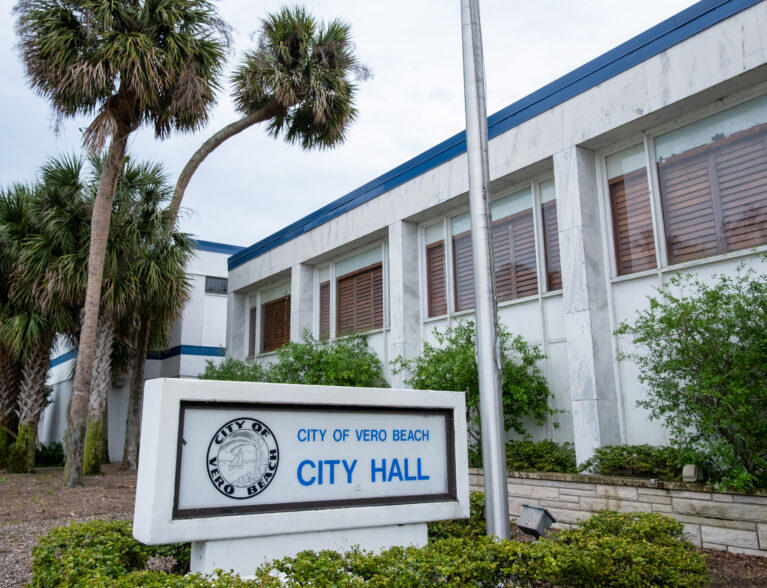
There’s no good reason for another referendum seeking to increase the residential density in the 50-acre core of downtown Vero Beach.
But the City Council is probably going to try again, anyway.
Why?
Because, it appears, at least three of the council’s five members stubbornly refuse to take the resounding “No!” voters gave to this question only eight months ago for an answer.
As they see it: The voters got it wrong, failing to fully comprehend exactly what the council was seeking and why it was so important.
In other words: What do voters know?
“A lot of the public that shows up to vote for stuff, they’re not here all the time,” Vice Mayor Linda Moore said at last week’s council meeting. “They’re not following.
“We did a less-than-stellar job of alerting the public to what the referendum meant, and I was never super-excited about the wording of it,” she added. “I think it needed to be much simpler.”
You know, so even voters could understand it.
Feeling insulted?
Moore, though, didn’t stop there.
She read from the dais a sample ballot question she created using artificial-intelligence technology, scaling back the proposed density-limit increase to 30 units per acre and conveniently omitting any reference to the total number of residential units that would be allowed in the downtown core.
For those who don’t remember: One of the two referendums overwhelmingly rejected in November asked Vero voters to more than double the downtown’s residential density – from 17 units per acre to 35 – and allow for the construction of up to 1,800 studio, one-bedroom and two-bedroom apartments.
The other ballot initiative would have allowed downtown property owners to transfer development rights.
Those proposed changes, we were told, were needed to enhance the city’s efforts to revitalize the downtown area that wasn’t close to reaching its potential.
“AI nailed it!” Moore said of her proposed, tech-generated referendum. “It uses all the nice words that people like.”
She stopped short of promising to treat citizens to ice cream if they behaved themselves and voted to approve the density increase, which was recommended by urban-planning guru Andres Duany, whom the city hired to produce the framework for a downtown master plan.
Moore left no doubt, however, that she believes many of the 5,200-plus voters who opposed the November referendums – more than 8,000 citizens cast ballots – did so because they failed to comprehend the proposals’ intent and impact, or they were frightened by the mere mention of a density increase.
It was as if she was unaware of the extent to which the local news media covered the downtown referendums. Or was it that she couldn’t grasp the possibility that thousands of knowledgeable voters rejected the referendums on their merit.
Either way, she wasn’t alone.
Councilman John Carroll – Moore’s fiercest ally in the struggle to take the city’s downtown to new heights – voiced support for putting a density increase on the November 2026 ballot.
“As a proponent of downtown, I think the only way that it’s going to redevelop is if we increase the density,” Carroll said. “I don’t think we have a choice, if we want to improve downtown.”
His stance was no surprise.
Speaking during a post-election special-call meeting on Jan. 28 to discuss the city’s options after voters rejected the downtown-density referendum, Carroll opened his remarks by saying: “What do you do when your dreams don’t come true?”
He then tag-teamed with Moore to give power-point presentations that offered alternative strategies and tactics the city could employ to make the downtown area more attractive to business and the community.
Two years ago, Carroll joined Moore in championing a wrongheaded movement to resurrect an oft-defeated proposal to reduce lanes of traffic along the Twin Pairs through the city’s downtown.
Their efforts failed, but they remain staunch supporters of a relentless vocal minority, a small-but-passionate group of downtown advocates who believe they know better and are determined to get what they want.
Indeed, these advocates feel a sense of urgency in pushing their agenda, knowing that Carroll and Moore – she co-owns the Kilted Mermaid craft beer and wine bar in the downtown area – could have less than two years left on the dais.
So, they’re probably disappointed with first-term Councilman Taylor Dingle, who embraces the need to improve the downtown area but boldly and responsibly disagreed with Moore’s suggestion that the density issue be put on the ballot again next year.
“I believe, as long as we have increased density on a referendum, it will fail,” Dingle said. “With the past attempt, the council had a lot of hopes of it passing, which, to some extent, made us delay some work in the downtown area.”
He’s not wrong.
Since the referendums’ defeat – and without the ability to increase residential density – the council and other city officials have stepped up their collaboration with downtown property owners and merchants in efforts to enhance the area.
Meanwhile, rookie Councilman Aaron Vos said he strongly supports a residential density increase in the downtown core, and he’s not opposed to giving such a referendum another shot.
But not now.
“Timing matters,” Vos said. “If it came up today, I’d say no. And, given the outcome of the failed referendum in November, initiating another vote within the next year is premature.”
Mayor John Cotugno, on the other hand, said he supported the 2024 referendum and, at this time, saw no reason he wouldn’t do the same in 2026, or whenever the city puts the density question to the voters again.
However, he suggested the downtown core could be further developed and revitalized without any significant increase in residential density.
To that end, Cotugno urged the city and downtown business community to continue along the enhancement path – sprucing up building facades, improving lighting and refurbishing Pocahontas Park – that they’ve followed in the months since the referendum failed last year.
Certainly, the neighborhood shouldn’t be ignored. But the noticeable lack of overall community support we’ve seen for downtown-improvement initiatives, such as the Twin Pairs lane-reduction proposal and residential-density referendum, raises doubts about how much of a priority it should be.
Also, when the council held that Jan. 28 special-call meeting to explore post-referendum downtown options, fewer than 40 people – mostly the usual suspects – occupied the chamber.
Despite scheduling the meeting for 6 p.m. in hopes of attracting younger adults who work daytime hours, not many cared enough to show up. The absence of that demographic was as telling as it was conspicuous.
Remember: Duany told council members last year that getting young people to live and socialize in the downtown area was the key to revitalization.
It would be nice, of course, if there were more reasons for younger adults, particularly those with college degrees in search of professional careers, to move here. It would also help to have more housing that young adults and families could afford.
Fact is, though, there is – and has been for decades – a noticeable shortage of both professional-type jobs and college-educated young adults in our growing county, where employment continues to be dominated by service-industry jobs. And without any meaningful influx of young adults on the horizon, the council might need to come up with a Plan B for making its downtown core a more desirable location.
Or, the city could simply accept Vero’s downtown for what it is – a convenient gathering place that is often buzzing with activity, a nice venue that continues to evolve in a way the community seems to like.



